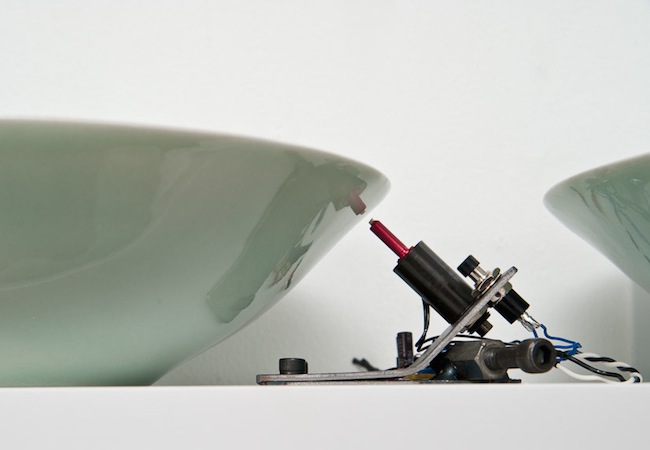This the first of two posts about Ian Johnston, a Canadian architect turned ceramist. This deals with his work done between 2007 and 2010. Next week, his ambitious touring installation Reinventing Consumption will be reviewed. If you do not know the installation art of Johnston that is a loss. If one were to compile a list of the top practitioners of this genre in ceramics, he would need to be near the top. At the same time you can be forgiven for this omission because Johnston has not shown much outside Canada.
He first came to my attention when he took part in “Critical Santa Fe: Developing Criticism in Ceramics” (October 27-30, 2010), organized by Jim Romberg and sponsored by the National Council on Education in the Ceramic Arts in my hometown of Santa Fe. Johnston gave me a catalog of a series of installations he had created under the umbrella Refuse Culture. It landed on top of a pile of other catalogs, all by chance of ceramic installations.
They had been gathered because I was in the process of writing an unflattering essay, “The Myth of Many, Installation Art in Ceramics.” It’s still in limbo for the time being and will appear soon. It seemed as though every catalog exposed how intellectually empty this approach had become.
Moreover, ceramics has a tradition of “many” that other media like painting do not share. In pottery works have always been made in series and in quantity, not as an elective aesthetic statement, but simply because that was the most efficient way to manufacture.
Misunderstanding the nature of the form, potters often think that installations can be done by simply sweeping up a number of their standard works from their shelves, arranging them together and giving them a title (the more pretentious the better). They believe, then, that they have done their job. This is an arrangement (as in flowers), not an installation. At best it can be a still life as was with Gwyn Hanssen Pigott’s Morandi-eque art.
In this state of mind I picked up his catalog expecting the worst because it dealt with what had also become a ceramic cliche, consumption. Every other pot today is presented as a sharp-toothed critique on mass-production (adding a lick of gold luster to the claim that power and money are being explored as well).
Happily, I was stunned by the intelligence and ambition of two of the works, Bag Suite in 4/4 Time and Machine For Singing. Everything about them- the scale, quality, quantity, originality and concept- combined with the actual environment in which they were placed. They were created to give the installation voice. Nothing was random.
All the forms were made new and were not part of Johnston’s prior repertoire, so he was not just retreading yesterday’s product. The vessels were all (more or less) identical as they stepped back, melted into the crowd and served the collective vision.
In depth descriptions of the works follow in the images below.
Garth Clark is the Chief Editor of CFile.
Above image: Ian Johnston, Machine for Singing, 2007-9, porcelain, wood, steel, carpet, electronic components, 50’ x 9” x 3” and 25’ x 30” 0.25”
Any thoughts about this post? Share yours in the comment box below.



Machine for Singing is an interactive piece installed in two rooms that are visually disconnected but within hearing distance of each other. The viewer engages the machine by walking on a carpet, activating pressure-sensitive switches under foot that send an electronic pulse to one of forty solenoids that in turn impact a fake Song dynasty bowl in another room. This piece engages the idea of cause and unknown effect, like the relations between consumers and makers of consumed objects. Machine for Singing is also a reflection on the demise of the idea of local as import and export of raw materials, product and waste destabilize geographic borders.





Ian Johnston, Bag Suite in 4/4 Time, 2007-8, porcelain, used retail shelving, fluorescent light fixtures, hemp rope, plastic bags, 52’ x 7’ x 4’. Courtesy of the Kelowna Art Gallery. Photography by Kyle L. Poirier.
An homage to the plastic bag and contemporary retail culture, Bag Suite in 4/4 Time, gives form to a controversial object facing extinction. Like many of the other objects explored in the Refuse Culture project, the plastic bag, a seemingly innocuous utilitarian article, when multiplied by the massive number of its users, exists at an unimaginable scale in the environment. Bag Suite consists of 432 slip cast porcelain vessels made at the Pottery Workshop Experimental Factory in China during Johnston’s residency in 2007.
The vessels were formed by pouring liquid plaster into a plastic bag. The lone gold vessel, the individual user, rests on a pillow of red plastic bags that were smuggled out of China in late 2007. Plastic bags were subsequently banned from use in China just in time for the Olympics. The collection is displayed on redundant four-foot retail store shelving and the entire piece is lit by a series of four-foot fluorescent tube lights.
There is a pall over this installation, a sense of utter barrenness. It is caused in part by the unflinching neon light which takes away any glamor or beauty and the ordered repetition. Aside from the gold bowl, nothing has any distinction, any identity, any humanity. It is, without becoming shrill, a kind of hell.
The Refuse Culture Project was shown in public art galleries in Alberta, Ontario and British Columbia from 2009 to 2011.
Machine for Singing by Ian Johnston is an interactive piece. The video was directed by Mark Andreas Kohl.
Visit the Kelowana Art Gallery

Add your valued opinion to this post.